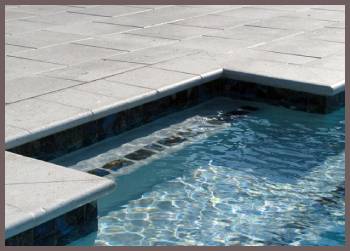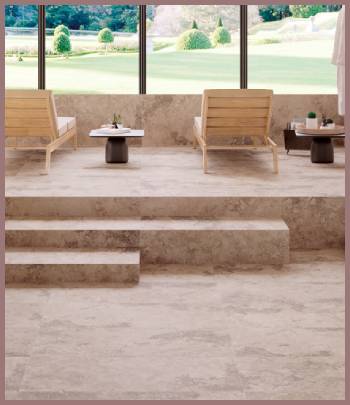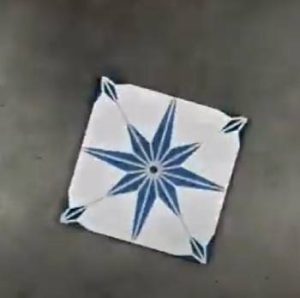When it comes to creating outdoor spaces that shine, two standout materials tend to top the charts – artistic pavers and travertine. As both provide excellent options for landscaping and outdoor design, the choice between the two often confounds homeowners.
This article will delve into the pros and cons of both these popular materials, providing insights to guide you on your home improvement journey.
A Brief Comparison Table
| Comparison Aspect | Artistic Pavers | Travertine |
| Material | Usually made from concrete | Natural stone |
| Aesthetic | Modern, customizable look | Luxurious, organic aesthetic |
| Versatility | High, available in various shapes, sizes, and colors | Medium, depends on the natural variations |
| Durability | High, resistant to cracking | High, but can chip and crack |
| Staining | Can stain, but can be mitigated with regular sealing | Can stain due to porous nature, requires regular sealing |
| Maintenance | Regular sealing required | Regular sealing required, complex to replace damaged tile |
| Heat Resistance | Depends on the color and material, darker pavers can get hot | High, stays cool even under high heat |
| Cost | Generally more affordable | More expensive due to extraction and transportation of natural stone |
| Installation | Can be DIY, or professionally installed | Requires professional installation |
| Effect on Home Value | Can enhance home value | Typically offers a higher increase in home value due to high-end appeal |
The Wonder of Artistic Pavers

Artistic pavers, also known as concrete pavers, have carved a niche for themselves in the world of home design. They are incredibly versatile, allowing for a plethora of patterns, colors, and designs. Let’s dig deeper into what makes these pavers a beloved choice and the potential drawbacks you may encounter.
Pros of Artistic Pavers
- Versatility
Artistic pavers offer an abundance of design possibilities. They come in various shapes, sizes, and colors, allowing homeowners to create unique patterns that mirror their design aesthetics.
- Durability
These pavers are sturdy and resist cracking, making them an excellent choice for high-traffic areas. Unlike other materials, you can replace individual pavers if damage occurs, reducing maintenance costs.
- Cost-Effectiveness
Artistic pavers are often more affordable than other materials, including travertine. This cost-effectiveness is a significant attraction for budget-conscious homeowners.
Read More: About Sono Eclipse Flooring
Cons of Artistic Pavers
- Staining
Although durable, artistic pavers are susceptible to staining. Things like oil, wine, and even leaves can leave hard-to-remove marks.
- Regular Maintenance
They require regular sealing to maintain their color and resist staining. This periodic upkeep can add to their total cost.
The Timeless Beauty of Travertine

Travertine, a natural stone, has been used in construction for millennia. It offers a unique, organic aesthetic that many homeowners find appealing. However, like any material, it has its pros and cons.
Pros of Travertine
- Aesthetics
Travertine is elegant and timeless, adding a touch of sophistication to any space. It also comes in various finishes, from polished to tumbled, catering to different style preferences.
- Increased Home Value
Given its high-end appeal, travertine can increase the value of your home, making it a smart investment.
- Heat Resistance
Unlike other stones, travertine stays cool underfoot even in high temperatures, making it perfect for pool surrounds or sunny patios.
Cons of Travertine
- Cost
Travertine tends to be more expensive than pavers due to its extraction, processing, and transportation costs. Its installation also requires professionals, adding to the overall expense.
- Maintenance
Although durable, travertine is porous, which can lead to stains and requires regular sealing.
- Possible Chipping
Unlike pavers, if a piece of travertine chips or cracks, it can be a complex process to replace the damaged tile.
FAQ Section
Yes, generally, travertine is more expensive than artistic pavers. The cost difference arises due to factors like quarrying, processing, and transportation of this natural stone.
Yes, artistic pavers can stain. They are susceptible to elements such as oil, wine, and leaves that can leave lasting marks. However, regular sealing can help mitigate this issue.
The main difference lies in the material and look. Travertine is a type of natural stone that offers a luxurious and organic aesthetic. On the other hand, artistic pavers are usually made of concrete and offer a more modern, customizable look.
While the exact cost can vary based on size, style, and region, travertine is generally more expensive than artistic pavers. The cost includes the material itself, transportation, and professional installation due to the complexity of working with natural stone.
Travertine offers a high-end, natural look that can increase home value. It is also cool to the touch, even in high heat. However, it is more expensive than other options and requires regular sealing to prevent stains. If a tile is damaged, replacing it can be a complex process.
Yes, because of its elegant and timeless appeal, installing travertine can increase the value of your home.
Read More: About Naturally Aged Flooring
A Comparison with Other Popular Materials
To give you a broader perspective, let’s compare travertine and artistic pavers to two of their closest competitors – flagstone and brick pavers.
Flagstone
Flagstone, another natural stone, is a popular choice due to its rustic, earthy aesthetic. It offers a similar upscale feel to travertine but has an entirely different look. Flagstone is known for its durability and slip-resistant surface, making it a great option for wet areas.
However, like travertine, flagstone is more expensive than artistic pavers and requires professional installation. It also requires regular sealing to maintain its appearance and durability.
Brick Pavers
Brick pavers offer a classic look that never goes out of style. They are durable and come in a variety of colors and sizes. Brick pavers are also eco-friendly, as they are often made from recycled materials.
On the downside, brick pavers can be more expensive than artistic pavers and less durable than travertine or flagstone. They also require regular maintenance, including cleaning and sealing, to prevent damage and preserve their look.
Conclusion
When deciding between artistic pavers and travertine, consider factors such as your budget, design preferences, the amount of maintenance you’re willing to commit to, and your desired return on investment.
While travertine may offer a higher-end look and potential increase in home value, artistic pavers are an excellent, cost-effective choice that offers tremendous design versatility. Remember, the best choice will depend on your unique situation and design vision.



